Jathurshan Pradeepkumar
TrialPanorama: Database and Benchmark for Systematic Review and Design of Clinical Trials
May 22, 2025Abstract:Developing artificial intelligence (AI) for vertical domains requires a solid data foundation for both training and evaluation. In this work, we introduce TrialPanorama, a large-scale, structured database comprising 1,657,476 clinical trial records aggregated from 15 global sources. The database captures key aspects of trial design and execution, including trial setups, interventions, conditions, biomarkers, and outcomes, and links them to standard biomedical ontologies such as DrugBank and MedDRA. This structured and ontology-grounded design enables TrialPanorama to serve as a unified, extensible resource for a wide range of clinical trial tasks, including trial planning, design, and summarization. To demonstrate its utility, we derive a suite of benchmark tasks directly from the TrialPanorama database. The benchmark spans eight tasks across two categories: three for systematic review (study search, study screening, and evidence summarization) and five for trial design (arm design, eligibility criteria, endpoint selection, sample size estimation, and trial completion assessment). The experiments using five state-of-the-art large language models (LLMs) show that while general-purpose LLMs exhibit some zero-shot capability, their performance is still inadequate for high-stakes clinical trial workflows. We release TrialPanorama database and the benchmark to facilitate further research on AI for clinical trials.
Single-Channel EEG Tokenization Through Time-Frequency Modeling
Feb 22, 2025Abstract:We introduce TFM-Tokenizer, a novel tokenization framework tailored for EEG analysis that transforms continuous, noisy brain signals into a sequence of discrete, well-represented tokens for various EEG tasks. Conventional approaches typically rely on continuous embeddings and inter-channel dependencies, which are limited in capturing inherent EEG features such as temporally unpredictable patterns and diverse oscillatory waveforms. In contrast, we hypothesize that critical time-frequency features can be effectively captured from a single channel. By learning tokens that encapsulate these intrinsic patterns within a single channel, our approach yields a scalable tokenizer adaptable across diverse EEG settings. We integrate the TFM-Tokenizer with a transformer-based TFM-Encoder, leveraging established pretraining techniques from natural language processing, such as masked token prediction, followed by downstream fine-tuning for various EEG tasks. Experiments across four EEG datasets show that TFM-Token outperforms state-of-the-art methods. On TUEV, our approach improves balanced accuracy and Cohen's Kappa by 5% over baselines. Comprehensive analysis of the learned tokens demonstrates their ability to capture class-distinctive features, enhance frequency representation, and ability to encode time-frequency motifs into distinct tokens, improving interpretability.
Automatically Labeling $200B Life-Saving Datasets: A Large Clinical Trial Outcome Benchmark
Jun 13, 2024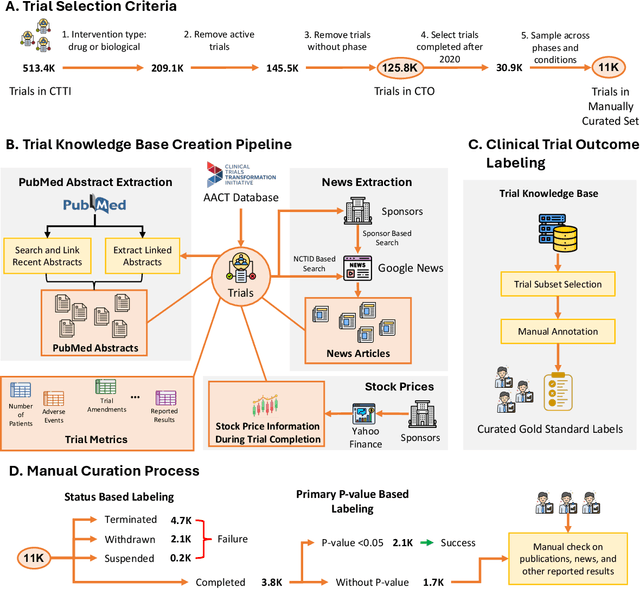
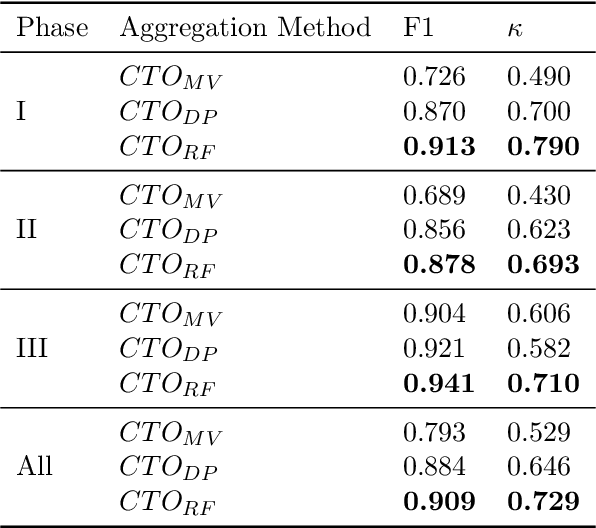


Abstract:The global cost of drug discovery and development exceeds $200 billion annually. The main results of drug discovery and development are the outcomes of clinical trials, which directly influence the regulatory approval of new drug candidates and ultimately affect patient outcomes. Despite their significance, large-scale, high-quality clinical trial outcome data are not readily available to the public. Suppose a large clinical trial outcome dataset is provided; machine learning researchers can potentially develop accurate prediction models using past trials and outcome labels, which could help prioritize and optimize therapeutic programs, ultimately benefiting patients. This paper introduces Clinical Trial Outcome (CTO) dataset, the largest trial outcome dataset with around 479K clinical trials, aggregating outcomes from multiple sources of weakly supervised labels, minimizing the noise from individual sources, and eliminating the need for human annotation. These sources include large language model (LLM) decisions on trial-related documents, news headline sentiments, stock prices of trial sponsors, trial linkages across phases, and other signals such as patient dropout rates and adverse events. CTO's labels show unprecedented agreement with supervised clinical trial outcome labels from test split of the supervised TOP dataset, with a 91 F1.
Contrastive Deep Encoding Enables Uncertainty-aware Machine-learning-assisted Histopathology
Sep 13, 2023



Abstract:Deep neural network models can learn clinically relevant features from millions of histopathology images. However generating high-quality annotations to train such models for each hospital, each cancer type, and each diagnostic task is prohibitively laborious. On the other hand, terabytes of training data -- while lacking reliable annotations -- are readily available in the public domain in some cases. In this work, we explore how these large datasets can be consciously utilized to pre-train deep networks to encode informative representations. We then fine-tune our pre-trained models on a fraction of annotated training data to perform specific downstream tasks. We show that our approach can reach the state-of-the-art (SOTA) for patch-level classification with only 1-10% randomly selected annotations compared to other SOTA approaches. Moreover, we propose an uncertainty-aware loss function, to quantify the model confidence during inference. Quantified uncertainty helps experts select the best instances to label for further training. Our uncertainty-aware labeling reaches the SOTA with significantly fewer annotations compared to random labeling. Last, we demonstrate how our pre-trained encoders can surpass current SOTA for whole-slide image classification with weak supervision. Our work lays the foundation for data and task-agnostic pre-trained deep networks with quantified uncertainty.
A Knowledge Distillation Framework For Enhancing Ear-EEG Based Sleep Staging With Scalp-EEG Data
Oct 27, 2022Abstract:Sleep plays a crucial role in the well-being of human lives. Traditional sleep studies using Polysomnography are associated with discomfort and often lower sleep quality caused by the acquisition setup. Previous works have focused on developing less obtrusive methods to conduct high-quality sleep studies, and ear-EEG is among popular alternatives. However, the performance of sleep staging based on ear-EEG is still inferior to scalp-EEG based sleep staging. In order to address the performance gap between scalp-EEG and ear-EEG based sleep staging, we propose a cross-modal knowledge distillation strategy, which is a domain adaptation approach. Our experiments and analysis validate the effectiveness of the proposed approach with existing architectures, where it enhances the accuracy of the ear-EEG based sleep staging by 3.46% and Cohen's kappa coefficient by a margin of 0.038.
Towards Interpretable Sleep Stage Classification Using Cross-Modal Transformers
Aug 15, 2022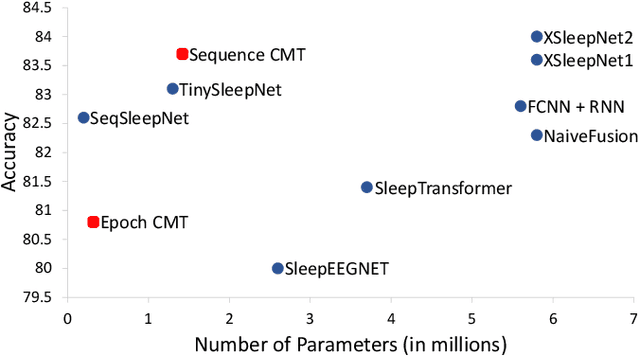
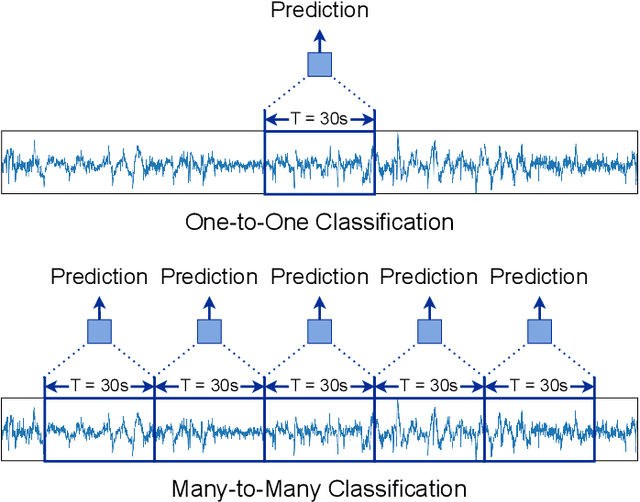
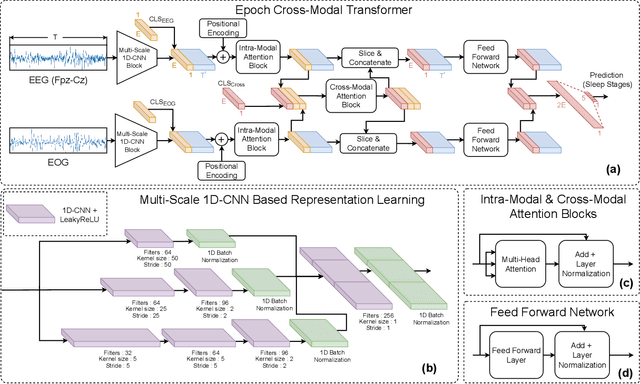
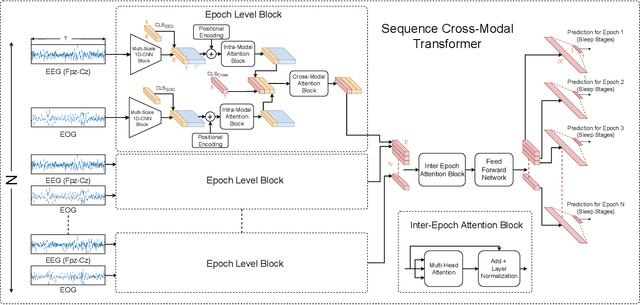
Abstract:Accurate sleep stage classification is significant for sleep health assessment. In recent years, several deep learning and machine learning based sleep staging algorithms have been developed and they have achieved performance on par with human annotation. Despite improved performance, a limitation of most deep-learning based algorithms is their Black-box behavior, which which have limited their use in clinical settings. Here, we propose Cross-Modal Transformers, which is a transformer-based method for sleep stage classification. Our models achieve both competitive performance with the state-of-the-art approaches and eliminates the Black-box behavior of deep-learning models by utilizing the interpretability aspect of the attention modules. The proposed cross-modal transformers consist of a novel cross-modal transformer encoder architecture along with a multi-scale 1-dimensional convolutional neural network for automatic representation learning. Our sleep stage classifier based on this design was able to achieve sleep stage classification performance on par with or better than the state-of-the-art approaches, along with interpretability, a fourfold reduction in the number of parameters and a reduced training time compared to the current state-of-the-art. Our code is available at https://github.com/Jathurshan0330/Cross-Modal-Transformer.
Towards Accurate Cross-Domain In-Bed Human Pose Estimation
Oct 07, 2021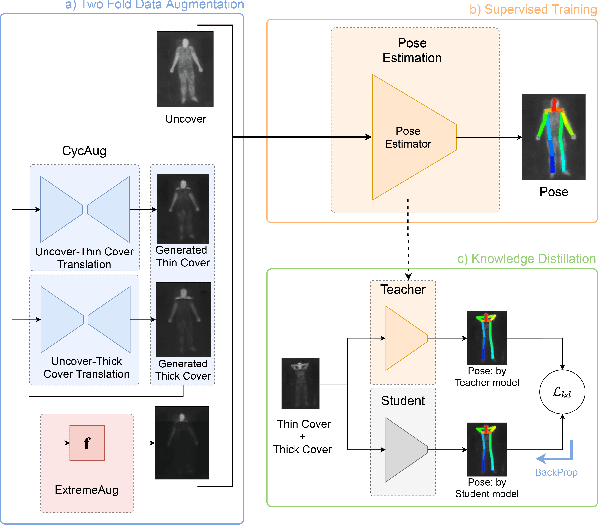
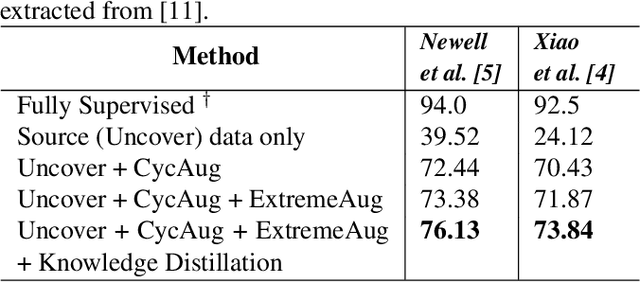
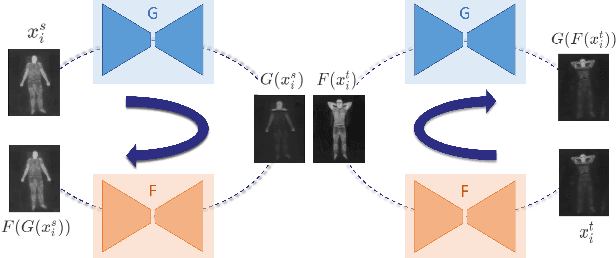
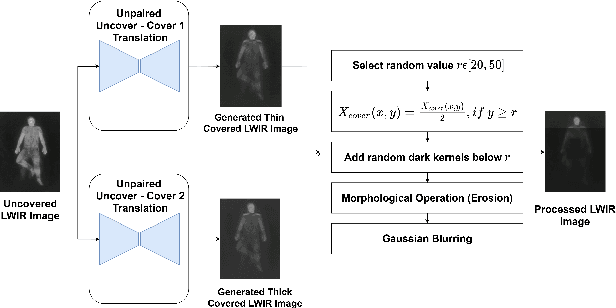
Abstract:Human behavioral monitoring during sleep is essential for various medical applications. Majority of the contactless human pose estimation algorithms are based on RGB modality, causing ineffectiveness in in-bed pose estimation due to occlusions by blankets and varying illumination conditions. Long-wavelength infrared (LWIR) modality based pose estimation algorithms overcome the aforementioned challenges; however, ground truth pose generations by a human annotator under such conditions are not feasible. A feasible solution to address this issue is to transfer the knowledge learned from images with pose labels and no occlusions, and adapt it towards real world conditions (occlusions due to blankets). In this paper, we propose a novel learning strategy comprises of two-fold data augmentation to reduce the cross-domain discrepancy and knowledge distillation to learn the distribution of unlabeled images in real world conditions. Our experiments and analysis show the effectiveness of our approach over multiple standard human pose estimation baselines.
 Add to Chrome
Add to Chrome Add to Firefox
Add to Firefox Add to Edge
Add to Edge